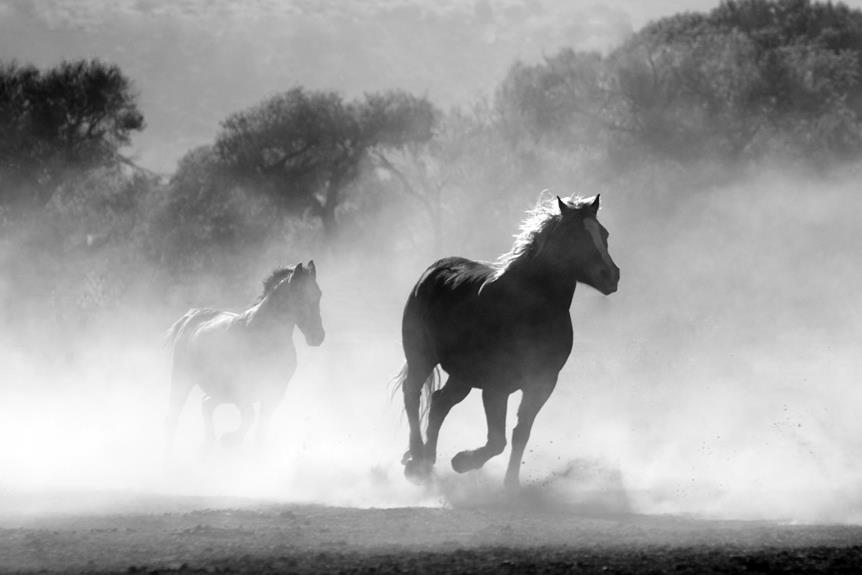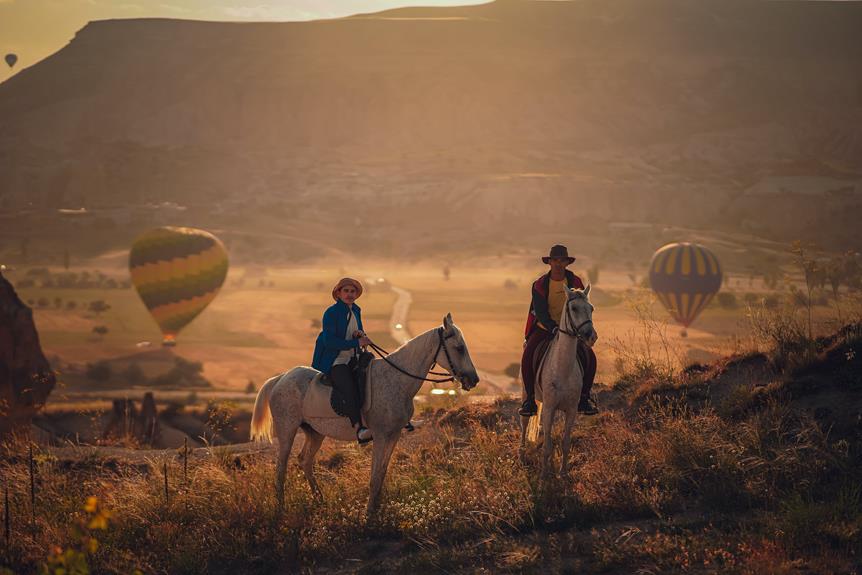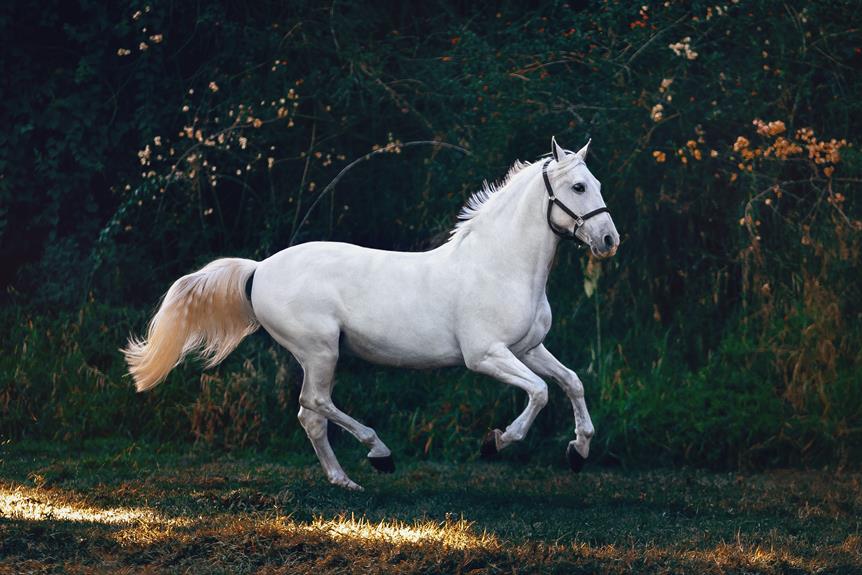Did you know that the height a horse can jump is not limited to a specific number?
It's a fascinating topic that involves various factors that determine a horse's jumping ability.
From breed and age to fitness level and rider skill, each element plays a crucial role in determining how high a horse can soar.
But just how high can they go? Well, that's what we're here to explore.
So, saddle up and let's delve into the world of equine athleticism to uncover the impressive heights that these majestic creatures can reach.
Key Takeaways
- Horses can jump heights ranging from three to seven-and-a-half feet, with the highest recorded jump being 8 feet 1.25 inches.
- Breed, age, fitness levels, and obstacle type are factors that influence a horse's jump height.
- Different breeds have varying natural jumping abilities, and younger horses tend to be better jumpers.
- Joint injuries, ligament damage, front feet pain, osteoarthritis, and wrist injuries are common injuries associated with horse jumping.
Horse Jumping Process
To successfully navigate a horse jump, you must master the five key phases of the process: Approach, Takeoff, In The Air, Landing, and The Getaway. Each phase plays a crucial role in ensuring a successful jump for both the horse and the rider.
During the Approach phase, it's important to introduce small jumps to the horse. This helps condition the horse for jumping and sets the tone for the actual jump. By gradually increasing the height of the jumps, the horse becomes more confident and prepared for higher jumps.
The Takeoff phase is where adequate speed and momentum come into play. Giving final commands to the horse and maintaining the correct position are essential for a successful takeoff. The rider must guide the horse towards the fence and ensure that the horse is in the right position to clear it.
Once in the air, the horse and rider must focus on maintaining balance and rhythm. This is the shortest phase, but it's crucial for a successful jump. The rider must stay centered and the horse must tuck its hind legs properly to clear the fence.
The Landing phase requires the rider to be prepared and ready to absorb the impact. The horse should land softly and smoothly, ready for the next phase.
Average Horse Jump
On average, horses are capable of jumping heights ranging from three to seven-and-a-half feet, depending on various factors such as breed, fitness level, and the type of obstacle.
Here are some fascinating facts about average horse jumps:
- The record for the highest horse jump stands at 8 feet 1.25 inches. This incredible feat was achieved by Huaso and his rider in 1949. The record still stands today, showcasing the remarkable ability of these magnificent creatures.
- Even an untrained horse can jump up to three feet. While this may not seem high compared to professional show jumpers, it's still impressive considering the lack of specialized training.
- Champion horses, with the right training and conditioning, can jump up to seven-and-a-half feet. These exceptional athletes push the boundaries of what a horse is capable of, demonstrating their incredible athleticism and power.
- The height a horse can jump is influenced by various factors, including breed, fitness level, height, and the type of obstacle. Thoroughbreds and warmbloods, known for their agility and athleticism, are often seen excelling in show jumping.
Famous High Jump Records
Now let's shift our focus to the impressive world of famous high jump records achieved by horses.
One notable record was set by Huaso and his rider, captain Alberto Larraguibel Morales, in 1949. Together, they cleared a fence measuring a staggering eight feet and one and a quarter inches (2.47 meters). Can you imagine the sheer power and athleticism required for such a feat?
As the horse leaves the ground, it propels itself upwards, using its hind legs to push off and its front legs to lift its body over the obstacle.
In addition to Huaso's record, there have been other remarkable achievements in the world of horse jumping. Optiebeurs Golo set the World Puissance Record at seven feet and ten and a half inches (2.40 meters) in 1991, while Sweet N Low holds the North American Record at seven feet and seven and a half inches (2.34 meters) since 1983. Lastic, ridden by Nick Skelton, also made history by setting the British Horse Jumping Record at seven feet and seven and fifty-six hundredths of an inch (2.32 meters) in 1978.
These incredible records demonstrate the incredible heights that horses can reach when it comes to jumping.
Factors Affecting Jump Height
Horse breed, age, fitness levels, height, and obstacle type all play a significant role in determining the jump height of a horse. Here are four factors that affect a horse's jumping ability:
- Breed: Different horse breeds have varying natural abilities when it comes to jumping. Some breeds, like the Thoroughbred, are known for their exceptional jumping skills due to their athletic build and long legs. On the other hand, breeds like the Shetland pony may not be able to jump as high due to their smaller size.
- Age: Younger horses tend to have more energy and agility, making them better jumpers. As horses age, their joints may become stiffer, which can affect their ability to clear higher fences.
- Fitness Levels: A horse's fitness level directly impacts its jump height. Horses that are in peak physical condition have the strength and stamina to jump higher. Regular exercise and conditioning are crucial for improving a horse's jumping ability.
- Obstacle Type: The type of obstacle a horse is jumping can also affect its jump height. Some obstacles, like water jumps or wide oxers, require more effort from the horse to clear. The height and width of the fence will determine the difficulty level for the horse.
Understanding these factors can help riders and trainers determine the best approach for improving a horse's jumping ability. By considering the breed, age, fitness levels, and obstacle type, one can optimize training techniques and set realistic goals for achieving higher jumps.
Injuries Associated With Jumping
Jumping can lead to various injuries in horses, including joint injuries and ligament damage. The stress placed on a horse's joints during takeoff and landing can lead to joint injuries such as arthritis. Overstretching of the suspensory ligaments supporting the horse's fetlock can also result in ligament damage associated with jumping. Landing on their toes during jumps can cause front feet pain for horses, potentially leading to injuries. Horses that are constantly engaged in physical activities without proper rest and nutrition are more susceptible to osteoarthritis due to the breakdown of cartilage. Another injury that can occur is slipped carpus, which affects the horse's wrists as a result of the impact during the landing phase of jumping.
To highlight the injuries associated with jumping, take a look at the table below:
| Injury Type | Description |
|---|---|
| Joint injuries | Arthritis caused by the stress on the horse's joints during takeoff and landing. |
| Ligament damage | Overstretching of the suspensory ligaments supporting the horse's fetlock. |
| Front feet pain | Landing on their toes during jumps can cause pain in the horse's front feet. |
| Osteoarthritis | Breakdown of cartilage in horses engaged in physical activities without rest. |
| Slipped carpus | Wrist injuries due to the impact during the landing phase of jumping. |
To prevent these injuries, trainers recommend proper training and conditioning for your horse. Gradually increase the height of jumps, allowing your horse to build strength and technique. It's important to train your horse to refuse a jump if they feel unable to clear an obstacle. Sudden braking or forcing a horse to jump higher than their capability can result in injuries. Additionally, ensuring your horse has proper rest periods and a balanced diet can help prevent injuries associated with jumping. Remember to prioritize the well-being of your horse to keep them healthy and sound for competitive jumping.
Frequently Asked Questions
How High Is the Highest Horse Jump Ever?
The highest horse jump ever recorded is 8 feet 1.25 inches. Factors like breed, training, and genetics affect a horse's jumping ability. Be cautious of jumping at extreme heights due to the dangers involved.
What Is the Max Horse Jump Height?
Horses can jump to impressive heights, influenced by factors like breed, fitness, and training. Genetics play a role too. To prevent injuries, proper training and conditioning are essential. Accurate measurement, rider technique, and choosing the right horse are key in jumping competitions.
What Horse Breed Has the Highest Jump?
The horse breed with the highest jump is the Chilean horse. They have set records in show jumping, reaching heights of 8 feet 1.25 inches. Their jumping abilities are a result of genetics and proper training.
How High of a Fence Can a Horse Jump Over?
Horses can jump fences of varying heights, depending on their breed, training, and physical condition. To improve your horse's jumping ability, focus on proper conditioning, choose the right saddle, and work on gridwork exercises. Avoid common mistakes and build confidence through training.
Conclusion
So, in conclusion, the height a horse can jump depends on various factors such as breed, age, fitness level, and rider skill. On average, horses can clear obstacles up to three feet, but champion horses have been known to jump as high as seven-and-a-half feet.
The highest recorded jump in show jumping history is 8 feet 1.25 inches. However, it's crucial to prioritize training, technique, and safety to avoid potential injuries while maximizing a horse's jumping potential.



0 Comments